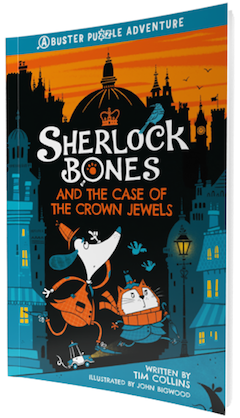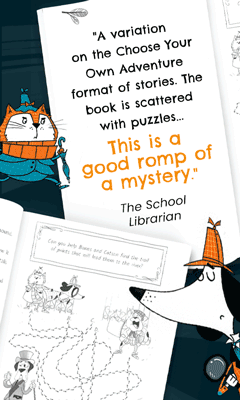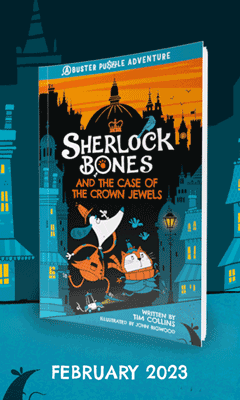Sherlock Bones and the Case of the Crown Jewels
by Tim Collins, illus. by John Bigwood
Sherlock Bones and the Case of the Crown Jewels encourages children to join the most famous of canine detectives--accompanied by his trusty feline sidekick--in an investigation that is mysterious and exciting enough to "really puzzle over." This interactive book is the first in a series and is filled with energetic spot illustrations and a variety of games that are sure to absorb budding sleuths.
Sherlock Bones of Barker Street feels "gloomy" when things are too quiet, so his good friend Dr. Jane Catson obligingly searches through her newspaper, The Morning Terrier, for an item of interest. Catson suggests that Holmes investigate a missing shipment of Swedish carrots or an heirloom pocket watch stolen from a large Doberman. Bones wants "a crime that's worthy of the front page, not page eight." The detective is delighted when he hears a large dog approaching: Inspector Bloodhound has arrived to ask for help with something big enough for Bones to really sink his teeth into.
The Queen's crown jewels have gone missing! "The most valuable jewels in the country" were stolen overnight from Kennel Palace without any of her guards noticing. Inspector Bloodhound tells Bones and Catson that his police pups uncovered three clues that morning at the palace, but the bloodhounds "need a little help working out what they mean." First, there was the "low rumbling noise" heard by a mole over on Kitten Mews; second, "some strange markings on a tree in the park opposite the palace"; and third, "a trail of prints leading away from a puddle on the front lawn." "The world's greatest detective" leaps into action, hat on head, magnifying glass in paw and Catson hot on his heels.
Even though the police pups have turned the front lawn outside the palace into "shapeless mush," Holmes manages to spot a trail of muddy prints going down to the river, across the bridge and up the hill to posh Kennel Heights. The footprints lead to the front door of actress Molly Ruffington (of Rover and Juliet and Catbeth fame), who reports that her diamond tiara has also been stolen. Holmes thinks the tiara thief and the crown jewel thief may be "one and the same person," and he and Catson continue searching the neighborhood. Holmes finds a scrap of paper announcing yet another robbery--a beloved pocket watch taken from a Doberman named Butch. The Doberman saw the "horrible" thief, and describes a "thick black tail, large ears, and sharp, werewolf-like teeth." There have been many other burglaries in the neighborhood, too: a wedding ring stolen from the wombats in number 166, a golden racing medal taken from the greyhound in number 121 and two silver brooches thieved from the vole in number 148.
Bones and Catson head back to Barker Street to ponder their troublesome case. When the sun sets, Bones leaps into action. He grabs a bucket of water, flags down a cab and heads back to Kennel Heights with Catson. They station themselves outside Molly's home until a muddy beast with a "cruel, savage look" and long teeth "as sharp as pins" emerges. Bones and Catson apprehend the despicable thief.
But this is only the beginning. Bones and Catson, still searching for the Queen's jewels, move onto the other clues gathered by Inspector Bloodhound and the police pups: the "low rumbling noise" and the "strange markings." Homes and Catson's investigation leads them through a dark tunnel where they evade a shrieking Sewer Phantom and out to the park where they apprehend a vicious cat. But the more clues they investigate, the longer their list of suspects becomes! After many twists and turns--and plenty of puzzles for readers to solve--Bones and Catson bring their case to a satisfying conclusion.
Award-winning author Tim Collins, whose books have been published in the U.S. and abroad, uses a witty and engaging style to fashion this twisty mystery. His action-packed text provides plenty of clues to encourage readers to guess the culprit's identity. Illustrator John Bigwood, working in pencil and Photoshop, does his part by offering up intricately designed visual problems that practically beg to be solved. At first, readers are asked to rearrange letters in a word finder to figure out which story will interest Bones. Then they can "help" Bones and Catson follow the trail of prints to the river. After that, they need to arrange panels in the correct order to reveal Butch the Doberman. One fun puzzle after another peppers the text until readers follow clues to the storage chamber where the jewels are hidden, identify the villain and even figure out which of the "excitable" police bloodhound pups receives their medal first. Answers are at the back of the book, ready to be accessed immediately or pondered together at the narrative's end. All in all, Sherlock Bones and the Case of the Crown Jewels--Bones's "trickiest case yet"--should have young readers brandishing their very own magnifying glasses. --Lynn Becker









 John Bigwood is an illustrator and graphic designer based in London. He has worked across a range of books for children and adults, including How to Draw People for the Artistically Anxious and the Sherlock Bones series. Shelf Awareness spoke with Bigwood about creating the art for Sherlock Bones and his own love of puzzles.
John Bigwood is an illustrator and graphic designer based in London. He has worked across a range of books for children and adults, including How to Draw People for the Artistically Anxious and the Sherlock Bones series. Shelf Awareness spoke with Bigwood about creating the art for Sherlock Bones and his own love of puzzles.